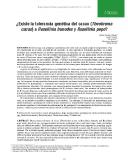| dc.contributor.author | García Córdoba, J. | |
| dc.contributor.author | George, A. | |
| dc.contributor.author | Argyle, T. | |
| dc.contributor.author | Hoopen, M. ten | |
| dc.contributor.author | Krauss, U. | |
| dc.date.accessioned | 2015-03-19T22:18:11Z | |
| dc.date.available | 2015-03-19T22:18:11Z | |
| dc.date.issued | 2005 | |
| dc.identifier | 470157 | es_ES |
| dc.identifier.issn | 1659-0082 | es_ES |
| dc.identifier.uri | https://repositorio.catie.ac.cr/handle/11554/6960 | |
| dc.description | 2 ilus. 3 tab. 43 referencias bibliográficas | es_ES |
| dc.description.abstract | Rosellinia spp. son patógenos oportunistas del suelo con un amplio rango de hospedantes. Una vez establecidos en el suelo, son difíciles de controlar. Se han sugerido la resistencia genética y el control biológico para complementar las medidas agronómicas. Sin embargo, casi no existe evidencia de resistencia hacia R. bunodes y R. pepo. En este estudio evaluamos progenitores de una polinización abierta de clones de cacao (Theobroma cacao) susceptibles (UF667, PA121 y CC222) y tres clones para los cuales se reportó cierta tolerancia hacia R. pepo (IMC67, Pound 7 y UF613) con respecto a su reacción frente a este patógeno, empleando un bioensayo con plántulas. No logramos estimar la reacción hacia R. bunodes. Además, analizamos las poblaciones de micoparásitos en la rizosfera de los clones puros utilizando "tortas mixtas" de hongos y R. bunodes como cebos. Rosellinia spp. are opportunistic soil-borne pathogens with a wide host range. Once established, they are difficult to control. Both genetic resistance and biocontrol have been suggested as promising supplements to cultural methods. However, evidence of tolerance towards R. bunodes and R. pepo is virtually non-existent. We evaluated openly pollinated progeny from three susceptible cocoa (Theobroma cacao) clones (UF667, PA121 and CC222) and three clones with a reported tolerance towards R. pepo (IMC67, Pound 7 and UF613) for their reaction towards this pathogen using a seedling bioassay. We were unable to test the reaction towards R. bunodes. We also analysed mycoparasite populations in the rhizosphere of the pure clones using "mixed fungal pies" and R. bunodes as baits. | es_ES |
| dc.language.iso | es | es_ES |
| dc.publisher | CATIE, Turrialba (Costa Rica) | es_ES |
| dc.subject | THEOBROMA CACAO | es_ES |
| dc.subject | ROSELLINIA | |
| dc.subject | GERMOPLASMA | |
| dc.subject | HONGOS | |
| dc.subject | ENTOMOPATOGENOS | |
| dc.subject | AGENTES DE CONTROL BIOLOGICO | |
| dc.subject | ORGANISMOS PATOGENOS | |
| dc.subject | ENFERMEDADES DE LAS PLANTAS | |
| dc.subject | METODOS DE CONTROL | |
| dc.title | ¿Existe la tolerancia genética del cacao (Theobroma cacao) a Rosellinia bunodes y Rosellinia pepo? | es_ES |
| dc.title.alternative | Does genetic tolerance of cocoa (Theobroma cacao) to Rosellinia bunodes and Rosellinia pepo exist? | es_ES |
| dc.type | Artículo | es_ES |


